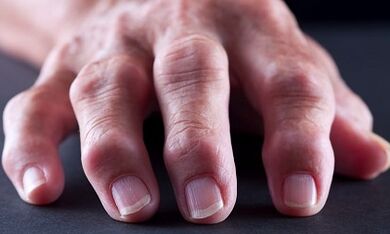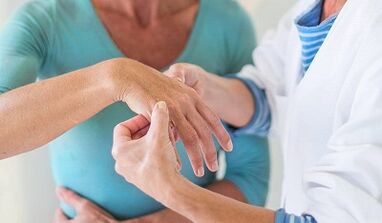Arthrosis and arthritis are diseases in which joints are affected.Since the names of these ailments are consonant, many people have thoughts about their identity.They perceive these terms as synonyms, suggesting that this is the same ailment.However, arthrosis and arthritis are far from the same, and there is a significant difference between it.In order to understand how arthrosis is different, let's find out what these diseases are.
What is arthritis?
Arthritis is a collective term that means inflammation of any joints and most often indicates more extensive and serious pathological disorders in the body.That is, the disease is inflammatory and can impress both one and several joints.
There are a number of ailments that are accompanied by the development of arthritis:
- rheumatism;
- gout;
- rheumatoid arthritis;
- systemic lupus erythematosus;
- psoriasis;
- Hemhramatosis.
In addition, there are reactive arthritis that develop as a result of complications after infectious diseases:
- flu;
- syphilis;
- gonorrhea;
- mycoplasmosis;
- chlamydia.
All these diseases are released in a separate group.
Inflammatory processes for arthritis affect primarily the synovial shell, and synovial fluid, causing a disease (synovitis).As a result, the amount of this liquid increases, which is interpreted by the swelling of the affected joints.The cartilage that covers the surfaces of the bones is also inflamed, and over time erosion that expresses the bone is formed on it.
What is arthrosis?

Arthrosis is an non -inflammatory dystrophic disease, which is associated with deformation and destruction of cartilage tissue inside the joint.That is, pathological changes occur, which are manifested by dystrophy of cartilage lining the surfaces of the bones.Although sometimes it is a long -term inflammatory process that provokes thinning and damage to the cartilage.Arthrosis is often observed in the elderly, since they wear cartilage tissue with age, and also osteoporosis occurs, which negatively affects the condition of the entire supporting and motor apparatus.
In some cases, arthrosis can occur at a young age in people experiencing long loads on the joints.This category includes athletes, people suffering from obesity or persons whose professional activity leads to rapid wear of the supporting and motor system.
The symptoms of the disease are caused by a violation of the functions of the cartilage, since they are thinned and deformed, bone tissue grows, which leads to the inability of the full performance of depreciation and friction of the bones that form the joint.As a result, the amount of synovial fluid is reduced, which should envelop the articular surfaces.
General reasons for the development of arthrosis and arthritis
Since arthrosis and arthritis affect the joints, and in general, the entire supporting - motor apparatus, these diseases develop as a result of many factors.
Let's look at ten reasons that cause these ailments:
- hereditary factor;
- metabolic violation;
- immune factor (especially for arthritis);
- congenital diseases of connective and bone tissue;
- joint injuries;
- overweight, obesity;
- excessive physical activity;
- unbalanced diet;
- hypothermia;
- infections.
These are general reasons that can cause both arthritis and arthrosis.But this is where their similarity ends.Further, the diseases have only differences.
Characteristic causes of the development of arthritis and arthrosis
Causes causing arthritis:

- an unbalanced, monotonous nutrition, which causes a violation of metabolic processes and immunity (poor nutrition provokes the development of infectious diseases, and their agents penetrate the synovial fluid and cause arthritis);
- strong hypothermia of the joint (overnight in the tent, bathing in cold water, poor poor -quality shoes and clothes);
- any injuries (stretching, bruise or fracture);
- smoking and obesity;
- A sedentary lifestyle.
The causes of arthrosis:
- hereditary factor;
- elderly age;
- injuries;
- metabolic diseases.
Previously, the primary (when the cause of the disease was unknown) and the secondary (when the cause was known) the stage in the development of arthrosis.As the more advanced diagnostic methods develop, the primary stage was called into question, since in all cases the main cause of the development of arthrosis is metabolic disorders in the form of carbohydrate metabolism and ferrous enzymes.Therefore, arthrosis can occur as a result of arthritis, since dystrophy of synovial fluid is nothing more than a metabolic disorder.In dystrophic processes, the blood circulation of the joint is disturbed, which leads to a deterioration in nutrition and the destruction of cartilage.
What is the difference between arthritis from arthrosis
Let's look at how arthrosis is different.Since arthritis and arthrosis often affect the same joints, then, despite this, there is still some pattern in the localization of the pathological process:
- Arthrosis often develops on large joints of the lower extremities (ankle, knee, hip).In addition, the pathological process develops in only one joint.Throughout life, all these joints experience very large loads, so it is not surprising that they wear out and destroy due to destructive processes.Rarely arthrosis affects the joints of the thumbs, hands and intervertebral joints.
- With arthritis, the joints are affected one by one, that is, the disease is characteristic of "flying".Suppose that the wrist joint was inflamed in one day, on the other - the elbow, on the third - the shoulder joint.In addition, several asymmetric joints can become inflamed at once.
In addition to the characteristic localization of the pathological process, there is a difference between arthritis and arthrosis in symptoms:
- With arthritis, pain occurs at night, when a person is at rest.And in the morning, patients feel characteristic stiffness in the affected joints.In order to relieve stiffness, they have to develop joints.Some patients interpret these phenomena as the norm, forgetting that healthy people do not need joint development after sleep.Their joints are always mobile and functional.With arthrosis, such stiffness is not observed.
- In the case of arthrosis, everything happens the other way around.At rest, the patient is relieved, since pain occurs only when moving and becomes more intense with significant motor activity.Sometimes, with arthrosis, pain may also occur at night, but they are associated with the fact that the patient changes the position of the affected limbs in a dream, which causes pain.
- The appearance of the joint with arthritis and arthrosis also differs.With arthritis, the metacarpal phalanx joints (convex bones of a compressed fist) swell and swell, blush and become hot (local temperature rises).With arthrosis, such symptoms are not observed, the joint looks absolutely normal.Of course, in the future, a joint deformation may occur as a result of the growth of osteophytes (bone growths on the joints), but even in this case there are no symptoms characteristic of arthritis.But with arthrosis, a crunch is observed in the affected joint, which is not with arthritis.
It should be noted the general condition of patients in these diseases.With arthritis, a person, in addition to pain in the joint, feels weakness, ailment of a general nature: subfebrile temperature, chills, headache, loss of appetite, decreased body weight.With arthrosis, the problem is only in a non -functional and painful joint, and general symptoms are not observed.
It should be noted that arthritis often leads to arthrosis, when the joint is destroyed and modified as a result of inflammation, and its mobility is also disturbed.However, with arthrosis, inflammatory processes are observed in the joints.It is not so simple to understand the diagnosis, you need to find out the root cause of the development of these ailments.Arthritis, as a rule, occurs against the background of infections that have entered the joint tissue, and in the case of arthrosis, the joint deformation occurs due to injury, in old age.Of course, sometimes inflammation can join, but this does not always happen.
Differential diagnosis of arthrosis and arthritis
In order to figure out what reason there were problems with the joint, it is necessary to conduct differential diagnosis.This diagnosis includes the following clinical tests:
- General blood test.
- general urine analysis;
- biochemical blood test;
- rheumatic tests;
- autoimmune norms (blood test for antibodies);
- X -ray of the affected joints;
- examination of synovial fluid;
- radioisotopic scanning of the skeleton (in some cases);
- computed tomography (CT);
- Magnetic - resonance tomography (CT or MRI).
Blood test for arthritis and arthrosis
For adequate diagnosis of articular diseases, this procedure is mandatory and necessary.In the case of arthrosis, the clinical picture of the blood does not change at all, it can only slightly increase the ROE (reaction of erythrocyte settlement) to 28-30 mm, usually with complication- synovitis.With arthritis, the blood picture completely changes: leukocytes increase to 14,000, a shift of the leukocyte formula to the left is observed, the level C - reactive protein (CRB) and ROE to 40 - 80 mm increases.
C - Jet in the blood

For differential diagnosis, a biochemical blood test must be carried out.With arthritis, there is an increase in inflammation of some immunoglobulins, seromucoid and C - reactive protein, which is not observed with arthrosis.The exact factor diagnosing the level of the inflammatory process in articular ailments is considered C - reactive protein (CRB).Since the synovial fluid reacts with increasing protein to the emerging inflammation, with inflammatory and autoimmune processes in the body, its level increases to 10 mg/l and higher.Compared to healthy people whose reactive protein in the blood does not exceed 0.002 g/l.Thus, the increased level of reactive protein in blood plasma eloquently indicates the development of arthritis.
C - reactive protein (CRB) is a protein of a quick phase that is synthesized in the liver.Activates the body's immune response to the invasion of an inflammatory factor.After 24 hours, the level of reactive protein in plasma rises ten times.With adequate treatment, the protein quickly decreases to normal indicators.With arthrosis in the patient’s blood, the reactive protein indicators remain normal.
X -ray of the affected joints
This diagnostic method is the second most effective after clinical blood test.In this case, arthrosis is precisely diagnosed, since the degree of bone deformation by the width of the joint gap can be determined on the radiograph.For arthritis, this method is not significant, although it is certainly prescribed as a diagnostic technique.However, this method is imperfect, since the degree of damage and destruction of cartilage tissue cannot be seen in the picture.
Differences in the treatment of arthritis and arthrosis
Arthritis and arthrosis have different causes and mechanisms of development, so their treatment is slightly different.
With arthritis, it is necessary first of all to identify the cause of the development of inflammation and neutralize it as soon as possible.If the occurrence of arthritis has an infectious etiology, then the patient is prescribed antibiotics.With the autoimmune origin of the disease, cytostatics and hormones are prescribed, and with gouty arthritis, uric acid correction in the body is necessary, therefore, treatment is carried out by hypoweminating drugs.
With arthrosis, the treatment is aimed at restoring cartilage tissue and the return of joint functions.Therefore, treatment is carried out by chondroprotectors, hyaluronic acid, physiotherapy, sanitary -resort treatment, massage and physiotherapy exercises.

Since both arthritis and arthrosis are accompanied by a pronounced pain syndrome, non -steroidal anti -inflammatory drugs for internal and external use (tablets and ointments) act as painkillers, with these ailments.Such drugs not only effectively eliminate pain, but also reduce signs of inflammation.
In the treatment of these ailments, both conservative treatment and surgical therapy are used.It all depends on the level and scale of articular lesions.As a rule, this is drug treatment and prosthetics.
Since the very fact of the patient’s chronic arthritis and arthrosis increases the likelihood of acute relapse, the therapeutic strategy should be aimed at preventing and preventing relapse.The following treatment is prescribed for this:
- The use of non -steroidal anti -inflammatory drugs (NSAIDs).Medicines of this group effectively eliminate signs of inflammation, especially with arthritis, but are always included in the therapeutic complex and with arthrosis.
- The rapid elimination of muscle spasm that occurs in muscles adjacent to the joint.Thus, the access of drugs, nutrients and oxygen is provided.
- Normalization of metabolic reactions.This is possible only after stopping the inflammatory process.
- Evacuation from the joint of uric acid salts (if we are talking about a violation of metabolic processes).
- Normalization of acid - alkaline metabolism.
Modern medicine has succeeded in the treatment of arthritis and arthrosis, but despite this, not every case of arthritis or arthrosis ends with complete success.
Achieving success in the treatment of these diseases is to relieve inflammation of the joint and muscle spasm, in the normalization of metabolic processes and acid -alkaline balance.As a result of these actions, the joint begins to receive full nutrition, oxygen and restore metabolic processes.
Recipes of traditional medicine are very effective in the complex treatment of arthritis and arthrosis.Their use in this format is approved even by official medicine.It should be immediately noted that medicinal herbs are only an auxiliary remedy in the fight against these ailments.Therefore, before proceeding with folk remedies, you should without fail to seek recommendations to the attending physician.
Eating for arthritis and arthrosis
All joints of the joints, without exception, require special dietary nutrition.Since the symptoms of arthritis affect the entire organism, in some cases its course is complicated by serious disorders in the work of the heart, kidneys and liver, and arthrosis can immobilize the patient, lead to disability and thereby reduce the quality of his life, it is necessary to throw all the forces to combat these ailments.

In the context of articular pathologies, the body should receive all the necessary nutrients, vitamins and minerals with a certain bias.Normalizing metabolic reactions and acid -alkaline equilibrium are paid attention to the products.
General nutrition recommendations can be as follows:
- limit the consumption of red meat (pork, beef, lamb, venison, horses);
- rejection of products containing a large amount of fats and trans fats;
- a complete rejection of alcohol;
- give preference to low -fat fish and seafood;
- consume a large number of vegetables, fruits and herbs (in any form);
- consumption of dishes based on cartilage: flood, jelly, jelly, marmalade;
- abundant drinking regime;
- Take dietary supplements with calcium, vitamins A, D and group V.
General prevention of arthritis and arthrosis
In the treatment of arthritis and arthrosis, the therapeutic strategy consists in preventing and preventing relapse of arthritis and arthrosis.After all, the disease is easier to warn than to treat.Therefore, the prevention of these ailments has the same principles:
- Avoid hypothermia of the legs (joints of the foot).After all, it is this path that is the main thing in exacerbation of chronic diseases and infection with viral infections.
- Timely relief of chronic ailments (tonsillitis, sinusitis, bronchitis).
- Refusal of uncomfortable high -heeled shoes.Unknown shoes create an additional load on the joints, which leads to their destruction, deformation and hyphen, and as a result to arthrosis.
- The fight against excess weight.Excess weight is a signal of metabolic disorders, and arthritis almost always occurs against the background of such violations.
- Moderate physical activity.Heavy work exerts pressure and load on the joint, as a result of which they are destroyed and inflamed.
- Be sure to adhere to a healthy lifestyle: often walk in the air, rest and eat, engage in physiotherapy exercises, regularly visit a doctor.
Physical physical education for arthritis and arthrosis is a very important part of therapy in a compartment with massage, diet therapy and physiotherapy.It provides sore joints with nutrients and oxygen, and without this their recovery and restoration cannot occur.
















































